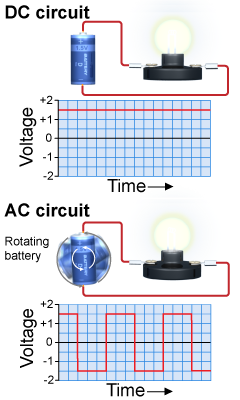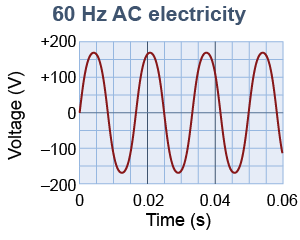|
The letters “DC” stand for direct current, the type of electricity produced by batteries. DC electricity was investigated by Italian physicists Luigi Galvani and Alessandro Volta around 1800. All of the circuits discussed so far in this chapter, and which you have built in the lab, have been DC circuits. Thomas Edison created the first electric light bulbs to operate on DC current. 
|
The electricity in your home is alternating current or AC. With AC electricity the polarity, meaning which wire is positive, changes many times per second. Imagine a battery on a rotating wheel with contacts that alternately connected the wires to opposite poles of the battery. The voltage on one wire would alternate back and forth between positive and negative. 
| 
|
If the voltage alternates, so does the current. When the voltage is positive the current in the circuit is clockwise (see the graph). When the voltage is negative the current flows in the opposite direction. In actual AC circuits, the hot wire carries an alternating voltage that alternates from positive to negative. The other wire is held at a constant zero volts. 
|
AC electricity is used for high-power applications because it is easier to generate and transmit over long distances. In Chapter 19 you will see that electric generators naturally make AC power. All the power lines you see overhead carry AC current. The plugs in the walls of your apartment or house or classroom also carry AC. 
 |
During the late 1880’s electricity was starting to reach into American homes and become more than a scientific curiosity. Thomas Edison and his Edison Electric Company had invested large sums in developing DC electricity systems in New York City and elsewhere.
At the time, DC technology was more efficient than AC, less expensive, and already had a network of paying customers. In 1880 all electricity customers were using the power for (Edison’s) light bulbs and a few DC electric motors. For safety reasons, however, DC voltage was limited to about 100 V all the way from the power plant to the consumer. At this voltage it took a lot of current to carry enough power for a neighborhood. High current results in high resistive losses so DC power plants had to be within a mile of the customer. This was a huge limitation to expanding electricity as a power source.
Rival inventor George Westinghouse recognized the advantages of AC electricity for large-scale distribution of electric power and challenged Edison’s DC technology. Developed first in Europe, AC transformers could efficiently change AC voltage without losing power. Power could be transmitted at 2,000 V then stepped down to a safe 120 V close to a neighborhood. A current of 1 A at 2,000 V carries 20 times as much power as 1 A of current at 100 V. Lower current means lower resistive losses and therefore power stations could be many miles away from the customer. By using transformers and high-voltage transmission lines, a single large AC power station could efficiently serve many more customers.
Westinghouse recognized that AC technology offered better scalability for the future growth of electricity even though it was not as well developed as the existing DC technology championed by Edison. Westinghouse and Edison waged a well-publicized campaign in which each touted the advantages of their chosen technology. A great deal of rhetoric was expended; in the end, the advantages of AC were so great that, today, DC electricity is used only for low-power situations, battery-driven machines, and a few very specialized transmission lines. 
|
 The 120 volt AC (VAC) electricity used in homes and businesses alternates between peak values of +170 V and −170 V. This kind of electricity is called 120 VAC because +120 V is the average positive voltage and −120 V is the average negative voltage. AC electricity is usually identified by the average voltage, not the peak voltage.
The 120 volt AC (VAC) electricity used in homes and businesses alternates between peak values of +170 V and −170 V. This kind of electricity is called 120 VAC because +120 V is the average positive voltage and −120 V is the average negative voltage. AC electricity is usually identified by the average voltage, not the peak voltage. 
|
The frequency of AC electricity is an important characteristic. In the USA, AC power alternates at a frequency of 60 Hz. This means the voltage on the same wire switches back and forth between positive and negative 60 times each second. European and some South American countries operate their power grids at 50 Hz and 220 V. The higher voltage and different frequency mean electrical devices designed for 120 V, 60 Hz power do not work, or are destroyed, by lower frequency, higher voltage European power. 
|
| |
|

